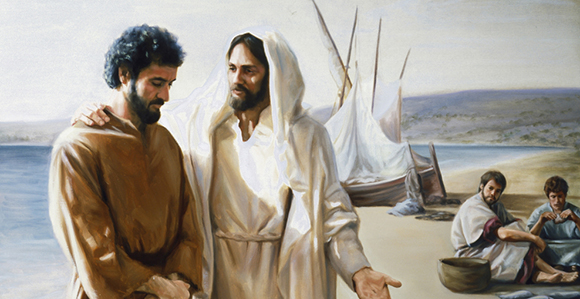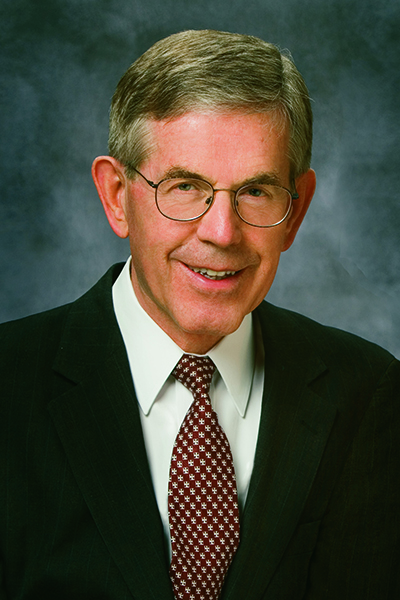Temple Ordinances Reflect Savior’s Atonement, Speaker Says
Contributed By R. Scott Lloyd, Church News staff writer

In a painting by David Lindsley the resurrected Christ is depicted as asking Peter, “Lovest thou me more than these?” Peter’s mortal and postmortal ministry was the subject of the Sperry Symposium October 24–25 at BYU.
Article Highlights
- The temple endowment represents a step-by-step ascent into the eternal presence.
- Simple obedience in attending the temple is not enough; we should understand why.
“When we focus mostly on the faith, repentance, baptism steps in that ascent, as crucial as they are, we’re seeing only the first steps of the spiritual staircase.” —Elder Bruce C. Hafen, emeritus General Authority
Related Links
PROVO, UTAH
Several historical clues indicate the Apostle Peter had and probably still has a significant responsibility for this latter-day gospel dispensation, “a kind of hands-on role that symbolizes the earthly use of the priesthood,” Elder Bruce C. Hafen, emeritus General Authority, said October 24 in the keynote address of the 43rd annual Sidney B. Sperry Symposium at Brigham Young University.
The symposium, held Friday evening, October 24, and Saturday morning, October 25, focused on the theme “The Ministry of Peter, the Chief Apostle.” It featured lectures from 28 scholars, most from BYU’s Provo campus with others from BYU–Idaho and elsewhere. Several of the presentations had already been published in a hardbound book that was available for purchase at the symposium and will be sold elsewhere. Elder Hafen’s address is not in the book but will be published in a future edition of the Religious Educator, said Frank F. Judd Jr., professor of ancient scripture and chairman of the symposium committee.
Elder Hafen addressed the topic “Peter, the Priesthood, the Temple, and Christ’s Atonement.”
“The Lord said as early as 1829 that He had given certain keys to Peter, James, and John that would be in effect until the Second Coming,” Elder Hafen noted. “Shortly after that, when John the Baptist conferred the Aaronic Priesthood upon Joseph and Oliver, he told them he acted under the direction of Peter, James, and John, who held the keys of the Melchizedek Priesthood, and not long after that the same three conferred that very priesthood on Joseph and Oliver.”
Less well known is Peter’s appearance at the dedication of the Kirtland Temple in 1836, “a visit that hints that Peter also has something to do with temples,” said Elder Hafen, who recently was released as president of the St. George Utah Temple.
“During the dedication, the witnesses who saw it said an angel entered through a window and took a seat next to Joseph Smith Sr.,” he recounted. “The Prophet Joseph later told the congregation that this angel was Peter, who had been sent as a messenger to accept the temple dedication.”
Elder Hafen asked, “Why would the Lord send Peter for that purpose? Maybe it’s because Peter holds the keys for the Melchizedek Priesthood, and the temple ordinances are the ordinances of that priesthood.

Elder Bruce C. Hafen, emeritus General Authority
“Thinking of Peter in this way prompts these further thoughts: The primary ordinances of the Aaronic Priesthood are baptism and the sacrament. These ordinances are intertwined with the first principles of the gospel. Is there possibly a similar relationship between the temple ordinances of the high priesthood and some of the higher gospel principles? If so, what are those higher principles, and what do they teach us about the natural pattern of our development as we move sequentially in our own lives in the pattern from the Aaronic Priesthood through the Melchizedek Priesthood stages of our personal growth, and could that pattern also prove a framework for applying Christ’s Atonement to our experience beyond the Aaronic Priesthood stage of baptism and confirmation?”
Whatever Peter’s duties are, Elder Hafen said, the high priesthood to which he evidently holds keys is clearly related to the higher ordinances of the temple. Citing Doctrine and Covenants 84, he said that only in the ordinances of the temple “can the power of godliness be manifest unto men in the flesh.”
Sometimes in the Church, the elements of the lesser, or Aaronic Priesthood are referred to in sequence as though they were the entire process of discipleship: faith in Christ and His Atonement, repentance, baptism, receiving the Holy Ghost, and enduring to the end, Brother Hafen observed.
“When we do that, ‘endure to the end’ can sound like an afterthought, as if our baptism and confirmation have hooked us like a trout on God’s fishing line, and as long as we don’t choose to squirm off the hook, He’ll reel us safely in.”
But there is more to enduring to the end, he said.
Quoting President David O. McKay, the ninth President of the Church, Elder Hafen explained that the temple endowment represents a step-by-step ascent into the eternal presence.
“But when we focus mostly on the faith, repentance, baptism steps in that ascent, as crucial as they are, we’re seeing only the first steps of the spiritual staircase,” Elder Hafen said.
He recounted the scriptural incident in which an angel came to Adam to ask why he offered sacrifices and Adam replied, “I know not, save the Lord commanded me.” The angel then said it was in similitude of the Only Begotten.
Elder Hafen observed: “Many of us go to the temple today the way Adam and Eve did at first. We go because we’re commanded, without really knowing why. The simple obedience is certainly better than not performing the ordinances at all. But the Lord who sent the angel must have wanted them to know why, and I believe He wants us to know why. Are today’s temple ordinances also a similitude of the Only Begotten?
“Think of how the temple’s altars are, like the altar of Adam and Eve, altars of prayer and sacrifice and covenant. Think of the dimensions of sacrifice in all of the covenants of the endowment. Since Christ completed His atoning mission, we no longer offer animal sacrifices, but we do covenant to sacrifice in what way?”
In answer to that question, Elder Hafen cited the commandment of the risen Christ to the Nephites: “Ye shall offer for a sacrifice unto me a broken heart and a contrite spirit” (3 Nephi 9:20).
